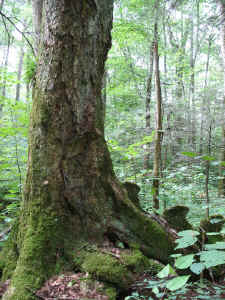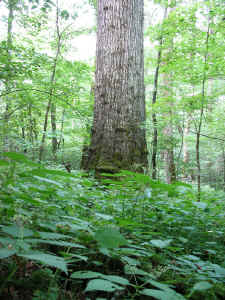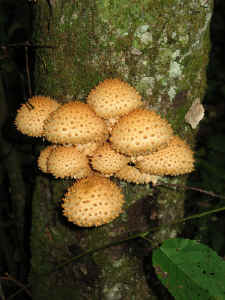Ents,

Beetree Red Oak: Beetree QURU: The largest northern red oak on Beetree Creek at
18'4.5" cbh and 116' tall. The trunk tapers slowly, so the tree is
likely the third largest volume northern red oak known.
|
Beetree
Creek flows southwest off Thomas Divide into Deep Creek
above Bryson City on the North Carolina side of the
Smokies. Gentle slopes line the upper half of the stream
and much of its main tributary, but
the drainage becomes much more gorge like approaching
Deep Creek where hemlocks and rhododendron line the
banks. However, a much more open
hardwood forest dominates the upper slopes. Even though
Thomas Divide remains near or above 5000' elevation for
all of the 3.5 miles between the main crest of the
Smokies and Beetree Creek, only scattered young
red spruce grow along the crest, and none creep down
into the Beetree Creek watershed. Instead, large
northern red oaks and colonies of beech dominate, many
of them dead from beech bark disease, and beech
sprouts, witch hobble, and blackberries underneath them.
In between the slopes, the stream starts out braided on
a narrow valley bottom and provides habitat for the only
yellow birches, hemlocks, stinging
nettle, jewelweed, and bee-balm in the immediate
vicinity. When the stream reaches the broader gentle
slopes starting at 4400' elevation, the nettle greatly
expands its coverage, but also mixes with many more
herbs on the richer soils. Blue cohosh, yellow mandarin,
waterleaf, and plantain-leaved sedge thrive in the flats
and adjacent slopes underneath basswood, buckeye, the
remaining beech, sugar maple, black birch, silverbell
and a few white ash. Only a few northern red oaks remain
in the canopy, but they reach even greater size than
those on the slopes above.
|
The rich forest, which would qualify as northern hardwood in the
southeast, continues only a few hundred yards downstream before
the
flats become substantially drier. From 4200' to the confluence
with
the main tributary at 3800', few herbs hide the forest floor,
but
dog-hobble obscures the ground along the stream, indicating more
acidic soils. In the same section, the parasitic buffalo nut is
the
primary shrub in the flats, and somewhat surprisingly given the
elevation, red maple and tuliptree form the overstory. The
tributary
is no richer with hemlocks along the stream and dog-hobble
creeping
farther up the slopes. However, basswood, sugar maple, and
buckeye
again grow prominently in some of the small coves above the
tributary.

A yellow birch on upper Beetree Creek with unusual growths on a root.
|

A 16'5" cbh x 120.1' tall northern red oak growing in the rich flats.
|
Few trees were measured on the trip; while the soils were rich
and
well watered in the upper flats, the elevation was too high for
most
species to approach their maximum dimensions. Above the flats, a
somewhat swollen, 17'10.5" cbh northern red oak was the
most
eye-catching tree. In the flats, a full-crowned, vigorous
northern
red oak will likely be larger than the tree upstream since the
tree is
already 16'5" cbh x 120.1' tall.

The base of the largest northern red oak on Beetree Creek:
18'4.5" cbh x 116' tall. (full tree image above)
|

Some mushrooms growing on a serviceberry snag by the largest
northern red oak.
|
However, that tree was
dwarfed by
another columnar northern red oak in the flats that is
18'4.5" cbh x
116' tall. The arrow straight trunk gradually tapers to a
massive
fork about 65' up, one side of which has been torn off by some
storm.
I know of only two other northern red oaks likely to exceed the
tree's
volume. An 8'6" black birch that topped 90' tall was the
only other
conspicuously large hardwood in the flats.
Jess Riddle
|